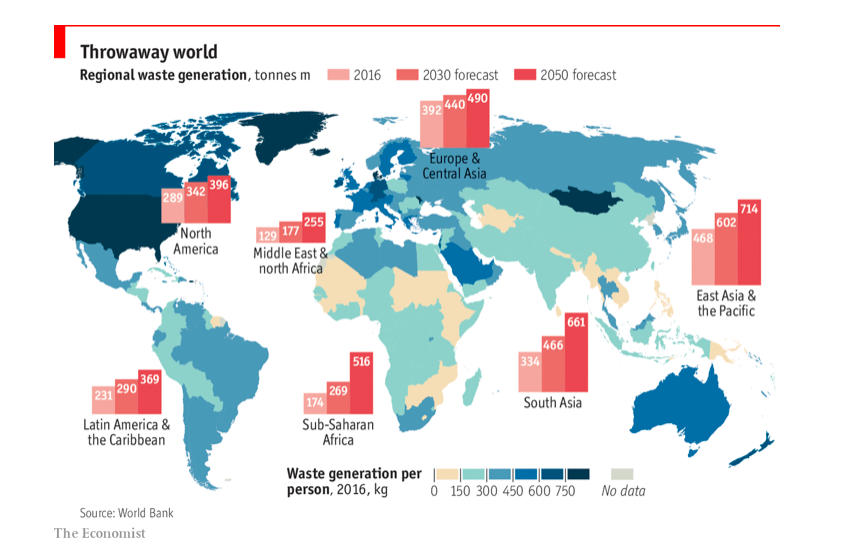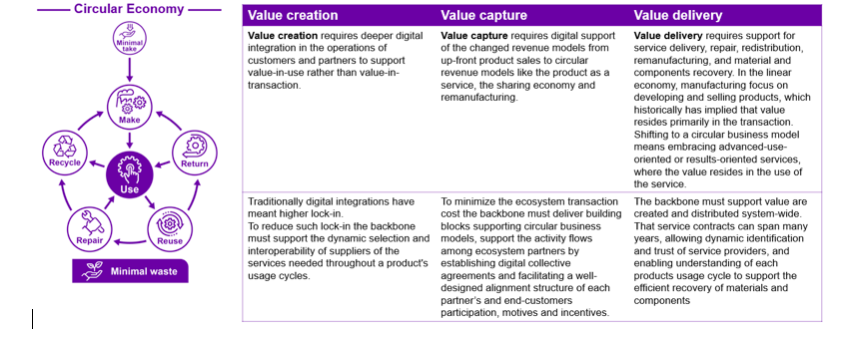To create a circular economy and complete business model, the digital business ecosystem must be designed to make important decisions and take action.
As companies enhance their digital processes, they must simultaneously implement circular business models and use digitalization to create interoperable and sustainable ecosystems that support engagement. circle and create new opportunities for innovation, differentiation, synergies, and jobs.
The development of the virtuous circle inherent in the economy will create efficiency, savings, and additional profits.
Ending dependence on finite natural resources
The circular economy decouples economic growth and development from the consumption of finite natural resources. It deploys principles and strategies to achieve global climate and environmental goals while increasing competitiveness and profitability.
It changes the way we produce and consume to be more agile, innovative, and resource-efficient, and it increases the flexibility of our supply chains.
A global circular economy makes sure that the concept of waste is just a comma in history.
Before the Industrial Revolution and mass production, waste was virtually non-existent; everything has been reused, repaired, and recreated. In our modern society, we consider materials unusable and products that no longer perform their original function.
This custom must be eradicated. If we are to achieve the global climate goals, while continuing to increase global wealth, we must ensure that the concept of waste does not become part of our modern society.
Materials and products must retain their economic value and never become unusable; instead, they will be continued in the journey to the next stage of use.

Eco-Centered Circular Economy
The most exciting opportunities for innovation and differentiation in the circular economy lie with organizations.
Companies using the competitive advantages of the circular economy work with partners in their ecosystem to create, capture, and deliver sustainable value.
By extending the life of products and parts and leveraging all of their use cycles, companies improve resource efficiency, and increase resiliency and customer loyalty, while creating new revenue streams.
The competitive circular business model works in all organizations and is ecosystem-centric.
This is compared to the traditional business-centric linear model, in which businesses mainly focus on selling the initial product to the next, not considering how to generate benefits in the future. throughout the full life of the product, and there is no business model that encourages extending product life.
Ecosystem cooperation is not only an opportunity but also includes challenges, such as interdependence, transaction costs, power relations, and the need for intermediaries in the system.
It should be noted that one of the results of improved circulation in commercial ecosystems is increased visibility due to the digitization and transparency of ecosystems. This is especially true in today’s age of supply chain fragility.

Digitizing the Business Ecosystem
An effective business ecosystem can only work if it is fully digitized. The ability to digitize to facilitate collaboration in the business ecosystem across geographies and organizations is critical to achieving a global circular economy.
To observe the successful digitization of the commerce ecosystem, we need to look at a new group of market leaders who are using digital platform models to achieve this.
They have a monopoly on interface and trust building, rely on historical investments in assets and services, and have exclusive insight into the behavior of the business ecosystem.
While pursuing an important ecosystem intermediary role in a centralized digital platform for a circular economy is attractive for an incumbent, it is difficult for companies to establish in the industry do.
Often, competitors are unwilling to cede power to rivals – established or emerging – and incumbents are unable to maintain a sufficient internal focus, organizational capacity, and financial resources to deploy a centralized digital platform for their industry’s circular business model.
To benefit from a digital ecosystem while also protecting against a centralized digital platform owned by a single dominant player, incumbents must realize a shared digital backbone for the platform towards a circular economy to accelerate the transition and reduce the time, cost, and risk of implementing circular business models.
Recent history shows how the emergence of shared multidisciplinary backbones has facilitated innovation and differentiation in the business ecosystem without monopolizing the infrastructure. copy.
The Internet shared molecular research – such as GenBank, railways, telephones, containerization of global trade, and electrification, are all examples.
A digital backbone for the circular economy would have the same impact in promoting competitive circular business models and putting the global climate goals within reach.
Now is the time to collaborate in a competitive and commercially neutral digital ecosystem that facilitates differentiation and innovation for all businesses and ensures digital interoperability. Seamless digitalization for all ecosystem participants.
Creating, Acquiring, and Delivering Value in a Circular Economy
Efficient digital collaboration within business ecosystems across the various usage cycles of products are key to enabling attractive circular business models and competitive user experiences.
Essential. Johan Frishammer and Vinit Parida explain that the move to a circular business model is an ambitious undertaking that requires organizations to rethink how they work with business ecosystems to create, capture and deliver value. increase.
The digital backbone of the circular economy must be designed to support rethinking on all three dimensions.

The requirement to move to a circular digital economy
Shift mindsets and internal biases from a narrow, enterprise-centric focus on transaction-based interactions to a broader, longer-term focus on ecosystem-centric collaboration. Shifting focus is a difficult but necessary task.
Established companies will meet “born circulars” as emerging industry leaders in the 2030s.
Leaders must lead their organizations to experience circular business models that will be the core business models of the 2030s. Companies must leverage their digital backbones to become more deeply integrated into their customers’ and partners’ operations.
Its aim is to create identification and trust, emphasize practical rather than transactional value, and launch new and innovative digitally supported services. This enables and improves joint value creation.
This move to a digital core forms the base layer for the move to a circular economy, ecosystem-centric business model. Leaders must embrace new ways of working and new principles that enable them to create, earn and deliver value.
Some organizations may choose to become Keystone players, Gaining experience through participation is important.
A shared global digital backbone for the circular economy offers other benefits in addition to co-creation with business ecosystem partners and customers.
It essentially provides visibility across the supply chain, paving the way for increased profitability and competitiveness while minimizing environmental damage.




Leave a Reply